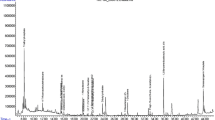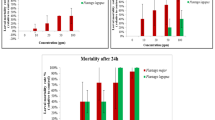Abstract
Endophytic microorganisms are fungi or bacteria which live inside plant tissues or organs, without causing them any harmful symptoms. Indeed, since many are also able to produce substances of biotechnological interest, they may protect the plant from insect attacks and diseases. The date palm, Phoenix dactylifera (Linnaeus) is a tree which has been known in Saudi Arabia for thousands of years as a staple food. The aim of the present work was to investigate the inhibitory activity of crude extracts of the fungal endophyte Cochliobolus spicifer (Nelson), isolated from the date palm, against Aedes caspius (Pallas) and Culex pipiens (Linnaeus) larvae. In addition, histological changes were determined in the digestive system of treated third instar larvae. The data showed that C. spicifer interfered with the developmental cycle of the mosquito, and had its strongest toxic effect (with 100 % mortality in third instar larvae) at concentrations of 300 ppm. This compound did not show toxicity to zebrafish. The third instar larvae treated with the active fraction showed cellular destruction and disorganization, cell spacing, and vacuolization of epithelial cells in small regions of the midgut. To the authors’ knowledge, this is the first study to report the isolation of endophytic fungi C. spicifer from date palm trees (P. dactylifera). The endophytic fungal extract of C. spicifer proved to be a strong candidate for a natural, safe, and stable phytolarvicidal to be used in population control of Ae. caspius and Cx. pipiens.




Similar content being viewed by others
References
Abdullah MAR, Merdan AI (1995) Distribution and ecology of the mosquito fauna in the southwestern Saudi Arabia. J Egypt Soc Parasitol 25(3):815–837
Addy HD, Piercey MM, Currah RS (2005) Microfungal endophytes in roots. Can J Bot 83(1):1–13
Ahmed AM, Shaalan EA, Aboul-Soud MAM, Tripet F, AL-Khedhairy AA (2011) Mosquito vectors survey in Al-Ahsaa district, eastern region, Kingdom of Saudi Arabia. J Insect Sci 11:1–11
Alabouvette C, Olivain C, Migheli Q, Steinberg C (2009) Microbiological control of soil-borne phytopathogenic fungi with special emphasis on wilt-inducing Fusarium oxysporum. New Phytol 184(3):529–544
Alcorn JL (1988) The taxonomy of “Helminthosporium” species. Annu Rev Phytopathol 26:37–56
Al-Khreji MA (2005) Survey and distribution of mosquito species (Diptera: Culicidae) and description of its habitat in Riyadh district, Kingdom of Saudi Arabia. M.Sc. thesis, King Saud University, Kingdom of Saudi Arabia
Amer A, Mehlhorn H (2006) Larvicidal effects of various essential oils against Aedes, Anopheles, and Culex larvae (Diptera, Culicidae). Parasitol Res 99:466–472
Arnold AE (2007) Understanding the diversity of foliar endophytic fungi: progress, challenges, and frontiers. Fungal Biol Rev 21:51–66
Arnold AE, Maynard Z, Gilbert GS, Coley PD, Kursar TA (2000) Are tropical fungal endophytes hyperdiverse? Ecol Lett 3(4):267–274
Arnold AE, Mejía LC, Kyllo D, Rojas EI, Maynard Z, Robbins N, Herre EA (2003) Fungal endophytes limit pathogen damage in a tropical tree. Proc Natl Acad Sci USA 100:15649–15654
Bancroft JD, Stevens A (1996) Theory and practice of histological techniques, 4th edn. Churchill Livingstone, Edinburgh
Büttiker W (1981) Observations on urban mosquitoes in Saudi Arabia. Fauna Saudi Arab 3:472–479
Cao LX, You JL, Zhou SN (2002) Endophytic fungi from Musa acuminata leaves and roots in South China. World J Microbiol Biotechnol 18(2):169–171
Carroll G (1988) Fungal endophytes in stems and leaves from latent pathogen to mutualistic symbiont. Ecology 69(1):2–9
Centers for Disease Control and Prevention (CDC) (2000) Outbreak of Rift Valley fever–Saudi Arabia, August–October, 2000. Morb Mortal Wkly 49(40):905–908
Chandrasekar G, Arner A, Kitambi SS, Dahlman-Wright K, Lendahl MA (2011) Developmental toxicity of the environmental pollutant 4-nonylphenol in zebrafish. Neurotoxicol Teratol 33(6):752–764
Chobba BI, Elleuch A, Ayadi I et al (2013) Fungal diversity in adult date palm (Phoenix dactylifera L.) revealed by culture-dependent and culture-independent approaches. J Zhejiang Univ Sci B 14(12):1084–1099
Dorworth CE, Callan BE (1996) Manipulation of endophytic fungi to promote their utility as vegetation biocontrol agents. In: Reddin SC, Carris LM (eds) Endophytic fungi in grasses and woody plants. APS, St. Paul
EMPRES (2000) Update on RVF outbreaks in Saudi Arabia and Yemen. Transbound Anim Dis Bull 4(15/3):4–8
Faeth SH (2002) Are endophytic fungi defensive plant mutualists? Oikos 98:25–36
Firáková S, Sturdíková M, Múcková M (2007) Bioactive secondary metabolites produced by microorganism associated with plants. Biologia 62:251–257
Gonthier P, Gennaro M, Nicolotti G (2006) Effect of water stress on endophytic mycota of Quercus robur. Fungal Divers 21:69–80
Grünig CR, Queloz V, Sieber TN, Holdenrieder O (2008) Dark septate endophytes (DSE) of the Phialocephala fortinii s.l. Acephala applanata species complex in tree roots: classification, population biology, and ecology. Botany 86(12):1355–1369
Huang Y, Wang J, Li G, Zheng Z, Su W (2001) Antitumor and antifungal activities in endophytic fungi isolated from pharmaceutical plants. FEMS Immunol Med Microbiol 31(2):163–167
Krings M, Taylor TN, Hass H, Kerp H, Dotzler N, Hermsen EJ (2007) Fungal endophytes in a 400-million-yr-old land plants: infection pathways, spatial distribution, and host response. New Phytol 174:648–657
Lopez-Romero F, Zuniga G et al (2012) Asymmetric patterns in the cranial skeleton of zebrafish (Danio rerio) exposed to sodium pentachlorophenate at different embryonic developmental stages. Ecotoxicol Environ Saf 84:25–31
Mattingly PF, Knight KL (1956) The mosquito of Arabia I. Bull Br Mus (Nat Hist) 4(3):91–141
McGrath P, Li CQ (2008) Zebrafish: a predictive model for assessing drug-induced toxicity. Drug Discov Today 13(9–10):394–401
Mejía LC, Rojas EI, Maynard Z, Bael SV, Aenold AE, Hebbar P, Samuels GJ, Robbins N, Herre EA (2008) Endophytic fungi as biocontrol agents of Theobroma cacao pathogens. Biol Control 4:4–14
Mizell M, Romig ES (1997) The aquatic vertebrate embryo as a sentinel for toxins: zebrafish embryo dechorionation and perivitelline space microinjection. Int J Dev Biol 41(2):411–423
Moser BA, Becnel JJ, White SE, Alfonso C, Kutish G, Shanker S, Almira E (2001) Morphological and molecular evidence that Culex nigripalpus baculovirus is an unusual member of the family Baculoviridae. J Gen Virol 82:283–297
Müller P, Döring M (2009) Isothermal DNA amplification facilitates the identification of a broad spectrum of bacteria, fungi and protozoa in Eleutherococcus sp. plant tissue cultures. Plant Cell Tissue Organ Cult 98(1):35–45
Nagel R (2002) DarT: the embryo test with the zebrafish Danio rerio—a general model in ecotoxicology and toxicology. ALTEX 19(Suppl 1):38–48
Omar MS (1996) A survey of bancroftian filariasis among South-East Asian expatriate workers in Saudi Arabia. Trop Med Int Health 1(2):155–160
Osterauer R, Kohler HR (2008) Temperature-dependent effects of the pesticides thiacloprid and diazinon on the embryonic development of zebrafish (Danio rerio). Aquat Toxicol 86(4):485–494
Pandey MR, Guo H (2014) Evaluation of cytotoxicity, genotoxicity and embryotoxicity of insecticide propoxur using flounder gill (FG) cells and zebrafish embryos. Toxicol In Vitro 28(3):340–353
Petrini O (1991) Fungal endophytes of tree leaves. In: Andrews JH, Hirano SS (eds) Microbial ecology of leaves. Springer, New York, pp 179–197
Piercey MM, Graham SW, Currah RS (2004) Patterns of genetic variation in Phialocephala fortinii across a broad latitudinal transect in Canada. Mycol Res 108:955–964
Porras-Alfaro A, Bayman P (2011) Hidden fungi, emergent properties: endophytes and microbiomes. Ann Rev Phytopathol 49:291–315
Rana BK, Singh UP, Taneja D (1997) Antifungal activity and kinetics of inhibition by essential oil isolated from leaves of Aegle marmelos. J Ethnopharmacol 57(1):29–34. doi:10.1016/S0378-8741(97)00044-5
Rathor HR (2009) The role of vectors in emerging and re-emerging diseases in the eastern Mediterranean region. Dengue Bull, 2000, December, vol 24 (online). http://www.searo.who.int/en/Section10/Section332/Section522_2535.htm. Accessed 20 Apr 2009
Saikkonen K, Helander M, Faeth SH, Schulthess F, Wilson D (1999) Endophyte–grass–herbivore interactions: the case of Neotyphodium endophytes in Arizona fescue populations. Oecologia 121:411–420
Sanders IR (2004) Plant and arbuscular mycorrhizal fungal diversity—are we looking at the relevant levels of diversity and are we using the right techniques? New Phytol 164:415–418
Schulz B, Boyle C (2005) The endophytic continuum. Mycol Res 109:661–686
Shi X, Gu A et al (2011) Developmental toxicity of cypermethrin in embryo-larval stages of zebrafish. Chemosphere 85(6):1010–1016
Shoemaker T, Boulianne C, Vincent MJ, Pezzanite L, Al-Qahtani MM, Al-Mazrou Y, Khan AS, Rollin PE, Swanepoel R, Ksiazek TG, Nichol ST (2002) Genetic analysis of viruses associated with emergence of Rift Valley fever in Saudi Arabia and Yemen, 2000–01. Emerg Infect Dis 8(12):1415–1420
Sieber TN (2002) Fungal root endophytes. In: Waisel Y, Eshel A, Kafkafi U (eds) The hidden half. Dekker, New York, pp 887–917
Sieber TN, Grünig CR (2006) Biodiversity of fungal root endophyte communities and populations, in particular of the dark septate endophyte Phialocephala fortinii s.l. In: Schulz B, Boyle C, Sieber T (eds) Microbial root endophytes. Springer, Berlin, pp 107–132
Silva VC, Pinheiro NL, Scherer PO, Falcão SS, Ribeiro VR, Mendes RMM, Chagas R, De Almeida MC, Mallet JRS (2008) Histology and ultrastructure of Aedes albopictus larval midgut infected with Bacillus thuringiensis var. israelensis. Microsc Res Tech 71:663–668
Sokolski S, Bernier-Cardou M, Piche MY, Berube JA (2007) Black spruce (Picea mariana) foliage hosts numerous and potentially endemic fungal endophytes. Can J For Res 37(9):1737–1747
Steinberg C, Edel V, Gautheron N, Abadie C, Vallaeys T, Alabouvette C (1997) Phenotypic characterization of natural populations of Fusarium oxysporum in relation to genotypic characterization. FEMS Microbiol Ecol 24(1):73–85. doi:10.1111/j.1574-6941.1997.tb00424.x
Tellenbach C (2011) Natural disease control by root endophytes in a changing climate. Ph.D. thesis, ETH Zürich, Zürich
Tellenbach C, Gunig CR, Sieber TN (2011) Negative effects on survival and performance of Norway spruce seedlings colonized by dark septate root endophytes are primarily isolate-dependent. Environ Microbiol 13(9):2508–2517
Usuki F, Narisawa H (2007) A mutualistic symbiosis between a dark septate endophytic fungus, Heteroconium chaetospira, and a nonmycorrhizal plant, Chinese cabbage. Mycologia 99:1275–1284
Vandenkoornhuyse P, Baldauf SL, Leyval C, Straczek J, Young JPW (2002) Evolution—extensive fungal diversity in plant roots. Science 295(5562):2051
Verma VC, Gond SK, Kumar A, Kharwar RN, Strobel G (2007) The endophytic mycoflora of bark, leaf and stem tissues of Azadirachta indica A. Juss (Neem) from Varanasi (India). Microb Ecol 54(1):119–125
Vyas N, Dua K, Prakash S (2007) Efficacy of Lagenidium giganteum metabolites on mosquito larvae with reference to nontarget organisms. Parasitol Res 101:385–390
Webber J (1981) A natural biological control of Dutch elm disease. Nature 292(5822):449–451. doi:10.1038/292449a0
White JF, Torres MS (2010) Is plant endophyte mediated defensive mutualism the result of oxidative stress protection? Physiol Plant 138(4):440–446
World Health Organization (WHO) (2004) Integrated vector management: strategic framework for the eastern Mediterranean region 2004–2010. The WHO Regional Office for the Eastern Mediterranean, Cairo
Xu T, Zhao J et al (2014) Pentachlorophenol exposure causes Warburg-like effects in zebrafish embryos at gastrulation stage. Toxicol Appl Pharmacol 277(2):183–191
Yan XN, Sikora RA, Zheng JW (2011) Potential use of cucumber (Cucumis sativus L.) endophytic fungi as seed treatment agents against root-knot nematode Meloidogyne incognita. J Zhejiang Univ Sci B (Biomed Biotechnol) 12(3):219–225. doi:10.1631/jzus.B1000165
Yang Y, Ma H et al (2014) Joint toxicity of permethrin and cypermethrin at sublethal concentrations to the embryo-larval zebrafish. Chemosphere 96:146–154
Acknowledgments
The authors would like to acknowledge the support of National Plan for Science, Technology, and Innovation (MAARIFAH), King Abdulaziz City for Science and Technology, Kingdom Saudi Arabia. Award number (11-BIO2112-02). This support is highly appreciated and acknowledged.
Author information
Authors and Affiliations
Corresponding author
Rights and permissions
About this article
Cite this article
Abutaha, N., Mashaly, A.M.A., Al-Mekhlafi, F.A. et al. Larvicidal activity of endophytic fungal extract of Cochliobolus spicifer (Pleosporales: Pleosporaceae) on Aedes caspius and Culex pipiens (Diptera: Culicidae). Appl Entomol Zool 50, 405–414 (2015). https://doi.org/10.1007/s13355-015-0347-6
Received:
Accepted:
Published:
Issue Date:
DOI: https://doi.org/10.1007/s13355-015-0347-6




